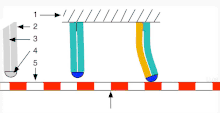Bimorph
A bimorph is a cantilever used for actuation or sensing which consists of two active layers. It can also have a passive layer between the two active layers. In contrast, a piezoelectric unimorph has only one active (i.e. piezoelectric) layer and one passive (i.e. non-piezoelectric) layer.

1 - substrate
2 - piezoelectric layer
3 - passive layer
4 - mechanical contact area
5 - track
Piezoelectric bimorph
The term bimorph is most commonly used with piezoelectric bimorphs. In actuator applications, one active layer contracts and the other expands if voltage is applied, thus the bimorph bends. In sensing applications, bending the bimorph produces voltage which can for example be used to measure displacement or acceleration. This mode can also be used for energy harvesting.[1]
Bimetal bimorph
A bimetal could be regarded as a thermally activated bimorph. The first theory about the bending of thermally activated bimorphs was given by Stoney.[2] Newer developments also enabled electrostatically activated bimorphs for the use in microelectromechanical systems.[3]
See also
References
- Al-Ashtari, W.; Hunstig, M..; Hemsel, T.; Sextro, W. (July 14, 2013), Characteristics of Piezoelectric Energy Harvesters in Autonomous Systems. Proceedings of 10th International Workshop on Piezoelectric Materials and Applications and 8th Energy Harvesting Workshop (PDF), retrieved January 31, 2016
- Stoney, G. Gerald (May 6, 1909). "The Tension of Metallic Films Deposited by Electrolysis". Proceedings of the Royal Society of London. 82 (553): 172–175. doi:10.1098/rspa.1909.0021.
- Conrad, Holger (December 11, 2015). "A small-gap electrostatic micro-actuator for large deflections". Nature Communications. 6: 10078. doi:10.1038/ncomms10078. PMC 4682043. PMID 26655557.